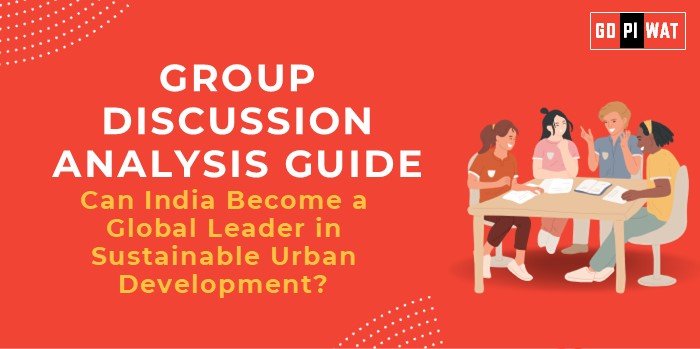📋 Group Discussion (GD) Analysis Guide: Can India Become a Global Leader in Sustainable Urban Development?
💡 Introduction to the Topic
- 📖 Context Setting: “As the world urbanizes rapidly, sustainable urban development has become a cornerstone of modern policymaking. India, with its booming cities and ambitious climate goals, stands at a critical juncture to position itself as a global leader in this domain.”
- 📜 Topic Background: Urban sustainability encompasses reducing carbon footprints, ensuring affordable housing, and creating resilient infrastructure. India has introduced initiatives like the Smart Cities Mission, AMRUT, and its net-zero pledge by 2070. However, challenges in execution and urban planning remain pivotal.
📊 Quick Facts and Key Statistics
- 🏙️ Urban Population: 35% of India’s population (2021) with projections of 600 million by 2030.
- 🌍 Global CO2 Rank: India is the third-largest emitter but aims to achieve net-zero by 2070.
- 🌟 Smart Cities Mission: 100 cities with a budget of ₹98,000 crore; over 70% projects completed as of 2024.
- ♻️ Urban Waste Management: India generates 65 million tons annually; only 20% processed sustainably.
- ⚡ Energy Efficiency: BEE saving 16 billion kWh annually through urban programs.
🌟 Stakeholders and Their Roles
- 🏛️ Government of India: Policy formulation, urban infrastructure funding, and regulatory frameworks.
- 🏢 Private Sector: Development of green technologies, public-private partnerships, and investments.
- 👥 Citizens: Responsible consumption, waste segregation, and civic engagement.
- 🌐 Global Agencies: UN Habitat, World Bank, and others providing expertise, funding, and monitoring frameworks.
📈 Achievements and Challenges
🏆 Achievements
- ✅ Smart Cities Mission: Over 5,000 projects launched, focusing on technology-driven urban solutions.
- ✅ Renewable Energy in Cities: Installed solar capacity of over 70 GW, with urban regions contributing significantly.
- ✅ Affordable Housing: PMAY-Urban has delivered 1.5 crore homes since 2015.
- ✅ Green Buildings: India is among the top three countries with certified green buildings.
⚠️ Challenges
- 🚧 Infrastructure Gaps: 40% of urban areas lack basic sanitation facilities.
- 🚧 Funding Shortfalls: Urban sustainability programs face a financing gap of $330 billion by 2030.
- 🚧 Urban Sprawl: Unplanned expansion strains existing resources.
- 🚧 Climate Resilience: Indian cities are vulnerable to floods, heatwaves, and air pollution.
🌍 Global Comparisons
- 🇸🇬 Singapore: Achieved water self-sufficiency via advanced urban planning.
- 🇩🇪 Germany: Innovations in waste management and circular economy implementation.
📜 Case Studies
- 🌱 Indore: Ranked India’s cleanest city for six consecutive years, exemplary in waste segregation and composting.
- ☀️ Ahmedabad: Pioneering in Bus Rapid Transit (BRT) and solar energy initiatives.
🗣️ Structured Arguments for Discussion
- 👍 Supporting Stance: “India’s proactive policies, such as the Smart Cities Mission, demonstrate its potential to lead the global urban sustainability agenda.”
- 👎 Opposing Stance: “India’s infrastructure gaps and limited funding indicate a long road ahead before it can claim global leadership.”
- ⚖️ Balanced Perspective: “While India has made notable strides, addressing systemic challenges is critical to achieving sustainable urbanization.”
💬 Effective Discussion Approaches
- 📈 Opening Approaches:
- Data-Driven: “With urban populations expected to double by 2030, sustainability is no longer optional but essential.”
- Global Benchmarking: “Singapore’s smart urban policies showcase what India could emulate to lead globally.”
- Problem-Solution: “Urban sprawl and climate vulnerability demand India innovate with urgency to ensure urban resilience.”
- ⚡ Counter-Argument Handling:
- Highlight policy gaps but emphasize emerging solutions like AI-driven urban planning.
- Use international examples to balance perspectives.
📋 Strategic Analysis of Strengths and Weaknesses
SWOT Analysis
- 💪 Strengths: Strong policy framework (e.g., AMRUT, Smart Cities Mission); growth in renewable energy adoption.
- ⚡ Weaknesses: Inefficiencies in urban waste management; high vulnerability to climate events.
- 🌟 Opportunities: Integration of AI and IoT in urban governance; global funding and partnerships.
- ⚠️ Threats: Escalating urban inequality; increasing natural disasters.
📚 Connecting with B-School Applications
- 🌏 Real-World Applications: Sustainable supply chain optimization in urban areas; financing models for urban sustainability projects.
- 📋 Sample Interview Questions:
- “How can public-private partnerships accelerate sustainable urban development in India?”
- “Discuss India’s Smart Cities Mission as a model for global leadership.”
- 💡 Insights for B-School Students:
- Focus on sustainable finance and urban policy development for projects.
- Learn from global best practices in urban resilience planning.


